Over 230 billion mobile apps were downloaded by users globally from 2016 to 2022, according to recent Statista data.
Companies are scrambling to create products that meet customer expectations as more people adopt mobile apps into their day-to-day lives.
Businesses increasingly leverage mobile apps to engage with customers and stay ahead of the competition. However, creating a successful app is a complex process and requires a strategic approach that takes into account the unique challenges and opportunities presented by mobile platforms.
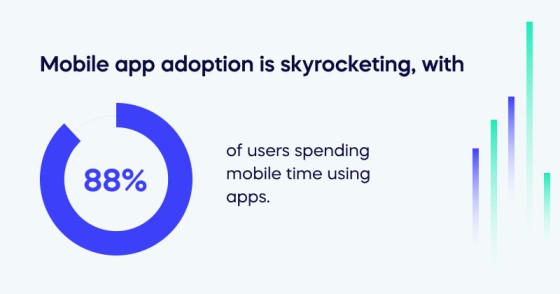
Mobile app adoption is skyrocketing, with 88% of users spending mobile time using apps. This provides a key opportunity for businesses to reach customers more meaningfully. But without a strategy tailored to the mobile app landscape, companies are missing out on a potentially lucrative market.
To increase mobile app adoption, businesses must embrace key strategies and best practices. These include identifying the target audience, building a friendly user experience design, optimizing app performance, and leveraging user feedback. Each of these elements is critical to the success of a mobile app and should be considered if you want a speedy development process.
Implementing these strategies and best practices can increase the adoption rate of business apps and achieve desired results. Whether you are a small business owner or a seasoned enterprise, understanding the importance of these elements and incorporating them into your app development process is vital for creating a successful mobile app.
This article will provide an overview of the strategies and best practices to increase mobile app adoption in 2023. It will cover target audience identification, user interface design, app performance optimization, and user feedback.
What is mobile app adoption?
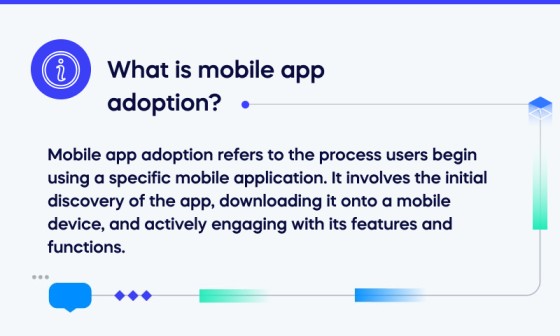
Mobile app adoption refers to the process users begin using a specific mobile application. It involves the initial discovery of the app, downloading it onto a mobile device, and actively engaging with its features and functions.
Factors such as user needs, app design, marketing efforts, and positive reviews can influence adoption. High levels of adoption are indicative of an app’s success, as they signify a growing user base and increased usage.
App developers and marketers often use targeted advertising and app store optimization strategies to maximize adoption rates and ensure long-term success.
Why is mobile app adoption important?
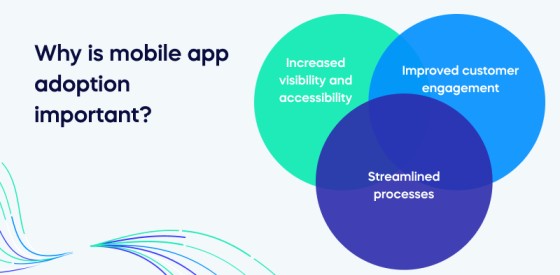
The rapid acceleration of technological change has led to an increasing need for businesses to adopt mobile apps. With the rise of smartphones and tablets, consumers now expect to be able to access information and services on the go, making mobile apps an essential tool for engaging with customers and staying competitive in today’s market.
Mobile apps offer several benefits, including increased visibility and accessibility, improved customer engagement, and streamlined processes. They also provide a convenient way for customers to interact with a brand, make purchases, and receive updates and notifications.
Mobile app adoption can help businesses keep up with the evolving digital landscape and stay ahead of the competition. By embracing new technologies and trends, companies can establish themselves as innovators in their field and attract a younger, tech-savvy audience.
How mobile application onboarding is different than adoption
Mobile application onboarding and adoption are two distinct phases in the user journey.
Onboarding refers to the user’s initial experience with an app when they first download and open it. It’s the process of guiding users through the app’s interface, features, and functionalities and helping them understand how to use it effectively.
Adoption is the stage where users begin to actively engage with the app, regularly using its features and interacting with its content. Adoption is about building habitual usage and loyalty among users.
The primary difference between onboarding and adoption is that onboarding is focused on introducing users to the core features and functionality of the app. In contrast, adoption is focused on encouraging users to make the app a regular part of their daily routine.
During onboarding, the focus is on educating users about how the app works and what it can do for them. The goal is to make a good first impression and ensure users understand the app’s value proposition. And during adoption, the focus is on reinforcing the value proposition by providing personalized experiences that keep users engaged and coming back for more.
While onboarding is about introducing users to the app and its capabilities, adoption is about building a long-term relationship that encourages users to make the app a regular part of their life.
Both stages are important for driving user engagement and increasing app retention.
Challenges with mobile app adoption
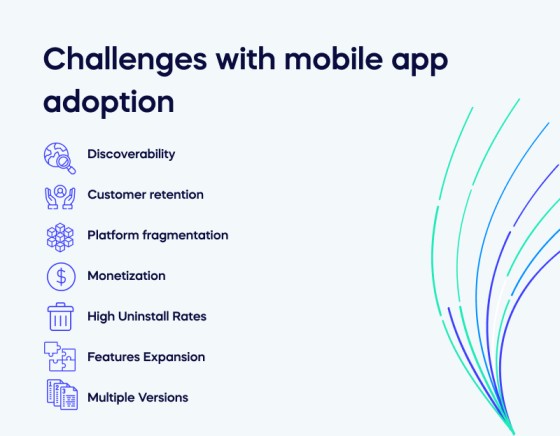
Mobile app adoption has become a critical aspect of the modern business landscape, allowing companies to reach customers where they are.
However, despite its potential benefits, mobile app adoption still poses several challenges.
Some of these challenges include:
- Discoverability: One of the biggest challenges of mobile app adoption is getting discovered by potential users. With millions of apps available in app stores, competition for user attention is fierce. This makes it challenging for new apps to get noticed and gain traction.
- Customer retention: Even if an app manages to attract users initially, keeping them engaged can be a challenge. App fatigue is a real phenomenon; many users uninstall apps after a few uses. To combat this, app developers must create engaging and compelling experiences that encourage users to return.
- Platform fragmentation: Another challenge of mobile app adoption is platform fragmentation. With so many mobile platforms and devices available, app developers must ensure their apps work seamlessly. This can be a complex and time-consuming task.
- Monetization: Monetizing mobile apps can be a significant challenge. With many users unwilling to pay for apps upfront, developers must find creative ways to generate revenue, such as in-app purchases or advertising.
- High Uninstall Rates: Users often delete apps after a few uses if they do not provide what they expect. High uninstall rates can indicate an app is not meeting user needs or providing a good user experience.
- Features Expansion: As technology advances, apps need to keep up to remain competitive. App developers must continually add new features and functionality to stay ahead of the curve and remain relevant.
- Multiple Versions: As devices and platforms evolve, app developers must create various versions of their apps to ensure they are compatible with new technologies. The problem with multi-version development is that it can be costly, time-consuming, and complex.
While mobile app adoption offers numerous benefits, it also presents significant challenges. Overcoming these challenges requires careful planning, user-centric design, and a willingness to adapt to changing market conditions.
12 strategies that drive mobile app adoption
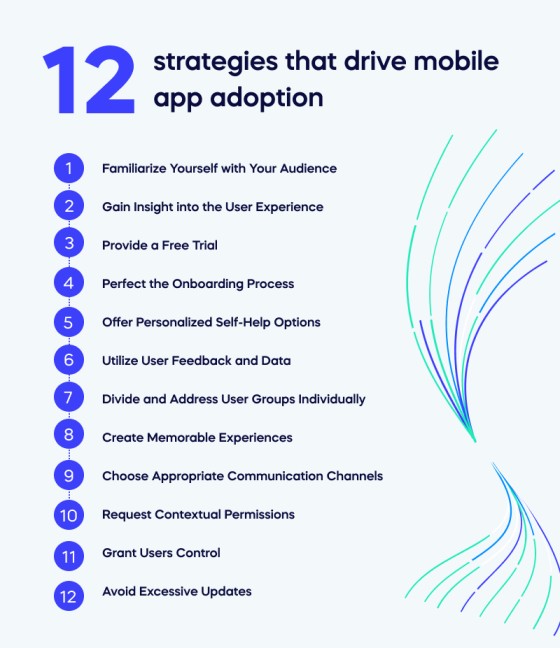
We recommend the following strategies to help you increase the adoption of your mobile app:
Familiarize Yourself with Your Audience
When improving mobile app adoption rates, getting to know your audience is critical.
By understanding your target audience, you can tailor your app to meet their specific needs and preferences. This requires conducting user research and gathering data on your target audience’s interests, demographics, and behaviors. Once you have this information, you can create a user persona representing your ideal customer. This will help you design an app that speaks directly to their needs and desires.
You can use several methods, such as surveys, focus groups, and analytics tools, to gather user data. Surveys are a great way to collect user feedback about their preferences and expectations for your app.
Focus groups allow you to gather more detailed feedback by observing users interacting with your app and asking questions about their experience. Analytics tools can help you track user behavior within your app, such as how long they spend using it, which features they use the most, and where they drop off in the user journey.
Gain Insight into the User Experience
Understanding the user experience is another key factor in increasing mobile app adoption rates. To gain insight into the user experience, you must conduct user testing and gather feedback from real users.
User testing involves observing users interact with your app and analyzing their behavior and feedback. This can help you identify any pain points or obstacles hindering app adoption.
To improve the user experience, consider implementing user-centered design principles. These principles emphasize designing apps that are intuitive, easy to use, and visually appealing. Use visuals and step-by-step instructions to guide users through onboarding and make the experience as straightforward as possible.
Consider incorporating interactive elements such as animations and gamification to make the app more engaging and enjoyable.
Provide a Free Trial
A free trial is an effective way to encourage users to try out your app without financial commitment.
It lets users get a feel for the app’s features and functionality before purchasing. Be sure to communicate the length of the trial period and the benefits of upgrading to the paid version.
To make the most of your free trial period, consider using it as an opportunity to gather user feedback. Encourage users to provide feedback on their experience with the app during the trial period. This can help you identify any issues or areas for improvement before the user decides whether or not to purchase the full version.
Perfect the Onboarding Process
The onboarding process is critical to mobile app adoption. Users who need help navigating the app during onboarding may abandon it entirely. To perfect the onboarding process, create an intuitive, user-friendly experience that guides users through the app’s features and functionality.
Consider implementing progressive onboarding, which involves gradually introducing users to the app’s features over time. This can help prevent users from feeling overwhelmed and improve retention rates.
Use visuals and step-by-step instructions to make the process as simple as possible. Consider incorporating in-app messaging and push notifications to keep users engaged and informed throughout onboarding.
Offer Personalized Self-Help Options
Personalized self-help options can help users troubleshoot any issues they may encounter while using your app.
Consider offering in-app support through a chatbot or knowledge base. This can help users find solutions to common problems quickly and easily.
Think about tailoring your self-help options to individual users’ needs and preferences to make them more effective. Use data such as user behavior and previous support requests to personalize the information provided.
Implement machine learning algorithms to automate the support process and provide users with customized recommendations based on their unique situations.
Utilize User Feedback and Data
User feedback and data can be incredibly valuable for improving app adoption rates.
Encourage users to provide feedback through surveys or in-app messaging. Use this information to make data-driven decisions about how to improve the app’s features and functionality.
Consider using sentiment analysis and clustering techniques when analyzing user feedback and data. Sentiment analysis involves analyzing users’ language to determine their emotional response to the app. Clustering involves grouping users based on common behaviors or characteristics.
These techniques can help you better understand user needs and preferences and use that knowledge to improve the app’s design and functionality.
Divide and Address User Groups Individually
Different user groups may have different needs and preferences regarding mobile app adoption.
Consider dividing your audience into segments and addressing each group individually. This can allow you to tailor your marketing and promotional efforts to each group’s unique needs and interests.
To divide your audience into segments, consider factors such as age, gender, location, and behavior within the app. Once you have identified these segments, use targeted marketing and promotional strategies to appeal to each group.
For example, if you target younger users, consider using social media influencers for promotion.
Create Memorable Experiences
Creating a memorable experience is critical to encouraging users to use your app. Focus on creating an app that is functional and enjoyable to use. Use engaging visuals, animations, and other interactive elements to create a fun and immersive user experience.
To create memorable experiences, consider using user-centered design principles and feedback from real users. Implement gamification elements such as rewards and achievements to encourage users to continue using the app.
Focus on creating a seamless user experience across all platforms and devices, ensuring that users can easily access and use your app no matter where they are.
Choose Appropriate Communication Channels
Choosing the right communication channels can increase mobile app adoption rates.
Consider where your target audience spends online and focus your communication efforts on those channels. For example, if your audience is active on social media, consider using social media advertising and influencer marketing to promote your app.
To determine the most appropriate communication channels, consider factors such as age, gender, location, and behavior within the app. Conduct market research to understand where your target audience spends their time online and what content they engage with.
Use this information to create targeted marketing campaigns that speak directly to your audience’s interests and needs.
Request Contextual Permissions
Requesting contextual permissions can help users feel more comfortable using your app. Be sure to communicate why certain permissions are necessary and how they will be used. Make it easy for users to revoke permissions if they change their minds later.
Contextual permissions are permissions that are requested at the time when they are needed. For example, if your app requires access to a user’s location, you might ask for permission when they try to use a location-based feature. This approach can help users feel more in control of their data and less concerned about privacy.
Grant Users Control
Giving users control over their experience can be a powerful way to encourage app adoption. Allow users to customize their app settings and preferences to fit their needs and preferences. This can help users feel more in control of their experience and more invested in the app as a whole.
To grant users control, consider implementing features such as customizable interfaces and push notifications. Allow users to control the frequency and type of notifications they receive and allow them to mute notifications altogether if they prefer.
Implement user preferences and settings, allowing users to customize their experience based on their needs and preferences.
Avoid Excessive Updates
While updates can be important for improving app functionality and adding new features, excessive updates can be a turnoff for users. Avoid bombarding users with too many updates too frequently.
Instead, focus on making meaningful updates that truly improve the user experience. Communicate clearly with users about what each update entails and how it will benefit them.
Use a release schedule that balances functionality improvements with user feedback to avoid excessive updates. Release updates in batches rather than individually to minimize interruptions for users.
Remember to communicate clearly with users about each update, including what changes have been made and how they will affect the user experience.
Mobile app adoption: Get it right and reap the rewards
Mobile app adoption has become an essential component of our daily lives. The proliferation of smartphones and the internet has paved the way for this trend.
Businesses can leverage technology through mobile apps to streamline their operations, reduce IT costs, and improve efficiency. But the most important factor to consider when looking at mobile app adoption is user engagement.
Time and time again, businesses fail to consider how their users will interact with the app and find themselves disappointed by low adoption rates. It’s unsurprising, given the complexity of mobile devices and the number of variables to consider when building a great app.
The next normal, spurred on by the COVID-19 pandemic, has accelerated the need for digital transformation and further highlighted the importance of mobile app adoption. Social distancing protocols have pushed businesses to rely more on mobile apps to keep their operations running and engage with customers remotely.
With the rapid pace of technological advancements, adopting mobile apps is crucial for businesses to stay ahead of the curve. Failure to do so could result in missed opportunities, reduced competitiveness, and decreased customer satisfaction. Therefore, companies must embrace mobile app adoption to remain relevant in today’s digital landscape..


